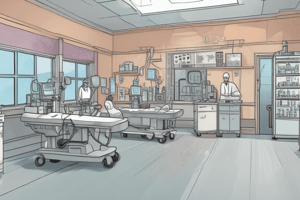Podcast
Questions and Answers
What is the definition of an error according to the Institute of Medicine and the Agency for Healthcare Research and Quality?
What is the definition of an error according to the Institute of Medicine and the Agency for Healthcare Research and Quality?
- A deliberate act to harm someone
- The failure of a planned action to be completed as intended or the use of a wrong plan to achieve an aim (correct)
- A situation where an intended outcome is achieved
- A minor mistake with no consequences
According to James Reason's principles of error management, what is the main goal of effective error management?
According to James Reason's principles of error management, what is the main goal of effective error management?
- To identify and punish individuals who make mistakes
- To achieve a one-time fix to the problem
- To eliminate human error completely
- To aim for continuous reform and improvement (correct)
What is a key characteristic of safety significant errors, according to James Reason's principles of error management?
What is a key characteristic of safety significant errors, according to James Reason's principles of error management?
- They can occur at all levels of the system (correct)
- They only occur at the lowest levels of the system
- They are always minor and have no consequences
- They are always intentional
Why is blaming individuals who make mistakes emotionally satisfying, but useless for solving the issues?
Why is blaming individuals who make mistakes emotionally satisfying, but useless for solving the issues?
What is the main difference between blame and accountability in the context of error management?
What is the main difference between blame and accountability in the context of error management?
What is the implication of the statement 'human error is both universal and inevitable'?
What is the implication of the statement 'human error is both universal and inevitable'?
What is the tendency to make mistakes or be wrong referred to as?
What is the tendency to make mistakes or be wrong referred to as?
Why do people make mistakes regardless of their experience, intelligence, motivation, or vigilance?
Why do people make mistakes regardless of their experience, intelligence, motivation, or vigilance?
What is the focus of the person approach in addressing human fallibility?
What is the focus of the person approach in addressing human fallibility?
What is the main goal of the system approach in addressing human fallibility?
What is the main goal of the system approach in addressing human fallibility?
What is the term for the influence of human and individual characteristics and organizational and job factors on behavior/performance at work?
What is the term for the influence of human and individual characteristics and organizational and job factors on behavior/performance at work?
What is a hazard in the workplace?
What is a hazard in the workplace?
How many human performance modes are there in which errors can occur?
How many human performance modes are there in which errors can occur?
What is an example of a skill-based performance mode?
What is an example of a skill-based performance mode?
What is the main characteristic of skill-based performance mode?
What is the main characteristic of skill-based performance mode?
What is the ultimate goal of applying human factors in the design of systems and tasks?
What is the ultimate goal of applying human factors in the design of systems and tasks?
What is a key factor that influences human performance in an organization?
What is a key factor that influences human performance in an organization?
What is the result of competing priorities or ill-defined expectations and work practices in an organization?
What is the result of competing priorities or ill-defined expectations and work practices in an organization?
What is the purpose of simplifying and standardizing organizational processes?
What is the purpose of simplifying and standardizing organizational processes?
What type of error occurs when an individual performs a routine, familiar task?
What type of error occurs when an individual performs a routine, familiar task?
What is the result of inexperience combined with a lack of supervision?
What is the result of inexperience combined with a lack of supervision?
What should leaders, peers, and subordinates do to encourage high levels of performance from individuals?
What should leaders, peers, and subordinates do to encourage high levels of performance from individuals?
What is the characteristic of Rule-based Performance Mode?
What is the characteristic of Rule-based Performance Mode?
What is the main difference between Slips and Lapses?
What is the main difference between Slips and Lapses?
What is the primary cause of Slips and Lapses?
What is the primary cause of Slips and Lapses?
What is the characteristic of Knowledge-based Performance Mode Errors?
What is the characteristic of Knowledge-based Performance Mode Errors?
What is the Availability Heuristic?
What is the Availability Heuristic?
What is the Hindsight Bias?
What is the Hindsight Bias?
What is the most important factor in preventing errors?
What is the most important factor in preventing errors?
What is the main difference between Mistakes and Errors?
What is the main difference between Mistakes and Errors?
What is the result of Confirmation Bias?
What is the result of Confirmation Bias?
What is the purpose of having contingencies in place?
What is the purpose of having contingencies in place?
Flashcards are hidden until you start studying





